Was Dracula an Irishman?
Published in 18th–19th - Century History, Features, Features, Issue 2 (Summer 2000), Volume 8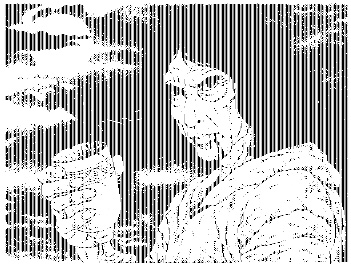
Abhartach by David Dale.
Dracula! The very name conjures up visions of mist-shrouded ruined castles in the mountains of Transylvania and of superstitious peasants huddled together in some Moldavian village inn. Forget all that—Dracula might be closer than you think! In fact, the true home of the vampire count might more correctly lie in Ireland!
Leacht Abhartach
In the north Derry area, between the towns of Garvagh and Dungiven, a district known as Glenullin (glen of the eagle) might give us a clue as to his origins. In the middle of a field in the remote townland of Slaughtaverty, is an area known locally as the ‘Giant’s Grave’ but which may be more properly described as Leacht Abhartach (Abhartach’s sepulchre). On the grave itself is a curling thorn bush under which lies a large and heavy stone. Originally there were more stones, the remnants of an old monument, but these have been removed over time by local farmers for building purposes. There is little doubt that the sepulchre was once an imposing place and that it has given the townland its name. But who was Abhartach?
During the fifth and sixth centuries, the Glenullin area was a patchwork of petty kingdoms, each with its own local ruler or ‘king’. These kings may have been little more than tribal warlords and there is ample evidence of their rule for the countryside is dotted with hill forts, ancient raths and early fortifications which marked their respective territories. Abhartach, according to tradition, was one of these chieftains. Local descriptions of him vary. Some say that he was a dwarf, others that he was deformed in some way, but most agree that he was a powerful wizard and was extremely evil. So evil, in fact, that those over whom he ruled wished to get rid of him. However, so terrified of him were they that they would not kill him themselves and so they persuaded another chieftain, Cathán, to perform the deed for them. Cathán slew Abhartach and buried him standing up in an isolated grave. However, the following day Abhartach returned, evil as ever and demanded a bowl of blood, drawn from the veins of his subjects, in order to sustain his vile corpse. In great terror, the people asked Cathán to slay him once more. This Cathán did, burying the corpse as before. But the following day, Abhartach returned again, demanding the same gory tribute from his people.
Cathan was puzzled and, depending upon the variant of the folktale, consulted either a local druid or an early Christian saint, as to why Abhartach could not be killed. There are several ‘hermitages’ in the area, according to tradition the dwellings of particularly holy men. The most notable is in Gortnamoyagh Forest on the very edge of Glenullin where local people will still point out ‘the saint’s track’—a series of stations near to a holy well. Close by was said to have been the hermitage of a saint known as Eoghan or John who is credited with founding a place of Christian worship in the area (the site is still known as Churchtown although any related foundation has long since vanished). A ‘footprint’ on a stony prominence in the forest is also attributed to this saint and it is said that from here he flew from Gortnamoyah to say Mass in his own foundation. His name further appears in several local placenames —Killowen in Coleraine (about fifteen miles away) and Magilligan (about twenty miles away). It was to this saint that Cathán is believed to have gone. The venerable old man listened long and hard to the chieftain’s tale.
One of the neamh-mhairbh
‘Abhartach is not really alive’, he told the astonished Cathán. ‘Through his devilish arts he has become one of the neamh-mhairbh [the undead]. Moreover, he is a dearg-diúlaí, a drinker of human blood. He cannot actually be slain—but he can be restrained.’ He then proceeded to give Cathán instructions as to how to ‘suspend’ the vampiric creature. Abhartach must be slain with a sword made from yew wood and must be buried upside down in the earth, thorns and ash twigs must be sprinkled around him and a heavy stone must be placed directly on top of him. Only then could the wizard be restrained in his grave. Should the stone be lifted, however, the vampire would be free to walk the earth once more.
Cathán returned to Glenullin and did what the holy man told him. Abhartach was slain with a wooden sword and was buried upside down with thorns placed all around the gravesite. On top of the actual grave, Cathán built a great leacht or sepulchre which could be seen for miles around. This has now vanished but the stone remains and a tree, which grew from the scattered thorns, rises above it.
The land on which the grave is situated has acquired a rather sinister reputation over the generations. Locally it is considered to be ‘bad ground’ and has been the subject of a number of family disagreements over the years. In 1997, attempts were made to clear the land and if local tradition is to be believed workmen who attempted to cut down the tree found that their brand-new chain-saw stopped without reason on three occasions.
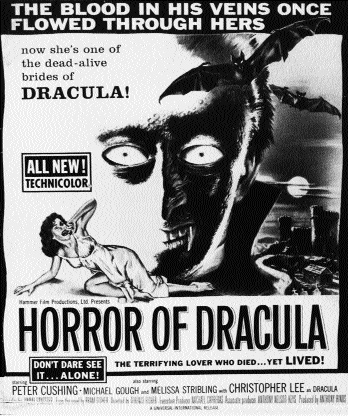
Poster for Hammer’s Horror of Dracula (1958)-it may be closer than you think!
When attempting to lift the great stone, an steel chain suddenly snapped, cutting the hand of one of the labourers and, significantly, allowing blood to soak into the ground. Although legends still abound in the locality of the ‘man who was buried three times’ and of a fantastic treasure which was buried with him, few local people will approach the grave, especially after dark! The current writer suffered a severe and inexplicable fall after visiting the site.
Part of an Irish vampire tradition?
This, then, in essence is the legend with its folkloric additions. But is it simply an isolated tale or does it fit into a tradition of Irish vampire tales which could have influenced Bram Stoker? The spilling of blood was not uncommon amongst the ancient Irish—indeed animal blood was ritually let under Christian directive upon St Martin’s Eve (11 November). The roots of this tradition undoubtedly go back into pagan times and may have a connection with the returning dead. The horrors of the Famine considerably added to the lore. The blood of pigs and cows supplemented a meagre diet—either drunk in a raw state or made into ‘relish cakes’ (a mixture of meal, vegetable tops and blood brought together in a kind of patty). Placenames in many areas which were badly stricken by the Hunger (for example in parts of Clare and Galway) reflect communal blood-letting sites.
Although most cultures have vampire stories, such tales have a particular resonance in Ireland. Here, interest in and veneration of the dead seems to have played a central part in Celtic thinking. One of the great festivals of the Celtic year—the Fáilte na Marhh (Feast of the Dead), celebrated on 31 October (Hallowe’en)—honoured the returning dead from beyond the grave or from the ‘Otherworld’. It was widely believed that these revenants were not vague and misty ghosts but substantial and corporeal beings who demanded to be looked after and fed. Legends abound around the Knocklayd Mountain region (about thirty miles from Slaughtaverty), concerning women who returned from the grave and threatened to eat their relatives out of house and home. And there are several tales in the Amey area of south Fermanagh of women who returned from the tomb in order to take small children back with them. Such beings were said to beat upon window panes late at night with long and extended fingernails, terrifying all within the household.
A more sinister variant of the revenant tale comes from the Dublin Mountains, in which a priest returns from the grave in order to threaten his mother. The implication of the story is that he wishes to drink her blood and do her harm. However, a locked door prevents this, although the woman is badly shaken. More explicit vampire stories come from Kerry. Tales concerning blood-drinking and flesh-eating ghouls were recorded in Sneem parish by Tadhg Ó Murchadha collecting for the Irish Folklore Commission in 1937 whilst vampiric beings were said to haunt the road on the Dingle peninsula between Dún Chaoin (Dunquin) and Baile an Fheirtéaraigh (Ballyferriter), near a spot known as Casadh na Graise, where two streams twine. Further, during a lecture in 1961, the Registrar of the National Folklore Commission, Seán Ó Suilleabháin (himself a Kerryman) mentioned a site which he called Dún Dreach-Fhoula (pronounced droc’ola) or Castle of the Blood Visage. This was allegedly a fortress, high up in the Magillycuddy Reeks, which was inhabited by blood-drinking fairies. It was said to guard a lonely pass but travellers in the region had to beware lest they become the prey of the dearg-diulai. Unfortunately, Ó Suilleabháin did not give any location for the evil fortress, nor does any further reference to it appear in any of his books. Neither does it appear in Breandán Ó Ciobháin’s list of placenames for the barony of Drumkerron (which includes the Magillycuddy Reeks) in Toponomiia Hiberniae. This does not mean that it does not exist and cultural historians such as the late Cathal Ó Sandair (1922-1996) and Peter Beresford-Ellis have long been engaged in hunting through private papers to try to determine its location.
Jeremiah Curtin in Irish Fairy Tales recounts another vampire story from Drimalegue parish, County Cork. In the story, ‘The Blood-drawing Ghost’, the dead person’s name is given as Michael Derrihy, son of Edward Derrihy. This vampire is no drifting wraith but a corporeal figure who forced a young girl to carry him on her shoulders all through the countryside whilst he slit the throats of sleepers with an open razor. Mixing their blood with oatmeal, he sat in each house and gorged himself on the gruesome feast. The story probably has its origins in the Famine period but it strongly connects the consumption of blood-soaked meal with the returning, vengeful dead.
The Black Hag
A legend from County Limerick mentions an evil abbess at Shanagolden Abbey during the late sixteenth/early seventeenth centuries, described (John Wardell and T.J. Westrop, ‘The History and Antiquities of Old St Catherine’s Abbey’ in Journal of the Royal Society of Antiquaries [1904]) as ‘a woman of the Fitzgeralds’, (thus linking her to local nobility) who allegedly drank the blood of novices in order to maintain her great age.
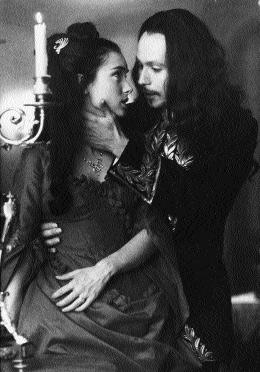
Winona Ryder as Mina and Gary Oldman as Dracula in Bram Stoker’s Dracula (1992)-could Stoker have been influenced by Irish legends of vampire-kings?
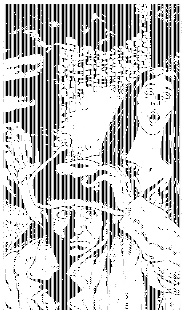
Castle of the Blood Visage by David Dale.
She was further regarded as a witch and as a ‘cup tasser’ (prophetess) whom the nobility of the countryside consulted before they made war on each other. After the abbey was abandoned, she continued to live there and was known locally as ‘the Black Hag’. Her blood-drinking ghost, condemned to remain there because of her past iniquities, is still said to haunt the ruins of the place.
A few other vampiric beings are strongly linked to local Irish aristocracy and chieftainship (as in the case of Abhartach). Carrigaphouca Castle (the term púca or pouca denoting an evil spirit—hence ‘rock of the evil spirit’), the ruins of which lie two miles west of Macroom, County Cork is one such place. This was a fifteenth-century MacCarthy stronghold. It is still an impressive ruin and many locals still genuflect when they pass by it. The site is said to be haunted by a blood-drinking spirit which may attack travellers and is reputedly linked to Cormac Tadhg MacCarthy whose stronghold this was in 1601. Cormac is still widely regarded as a traitor who betrayed his kinsmen to English domination in return for a knighthood and for being made Sheriff of Cork. He is said to have supervised the execution of the rebel James Fitzgerald who ‘was cut into little pieces when yet alive’. The implication in many variants of this tale was that Cormac was actually possessed by an evil spirit which had come out of the rock on which his fortress stood. The castle was destroyed in 1690 during the Williamite conflict and has remained a ruin ever since. A similar legend concerns Tadhg Caoch (‘One-eyed Tadhg’) O’Carroll, one of the ‘Dark Princes of Ely’, who slew his brother Thaddeus (reputedly a priest) across the altar-rails in the Bloody Chapel of Leap Castle in south Offaly. Because of this blasphemy, his evil soul was denied entry to the afterlife and must remain within the castle, sustaining itself on the blood of all that come near it. Both are sometimes referred to as ‘derrick dallys’ which would seem to be an Anglicisation of dearg-diúlaí, a blood-drinker or vampire.
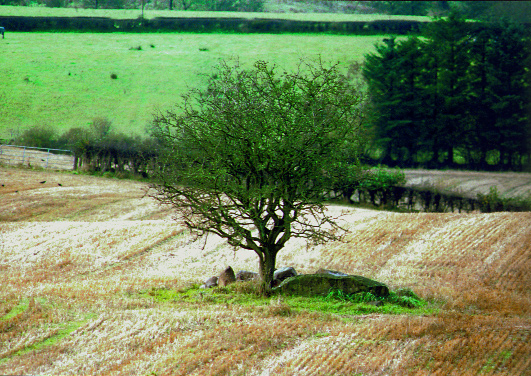
The thornbush at Leacht Abhartach (Abhartach’s sepulchre) from which the townland of Slaughtaverty, County Derry, takes its name. (Paul Nash)
Many Irish locations bear references to supernatural entities. Glennascaul, County Galway, in Irish is Gleann an Scáil (the valley of the phantom); Drumarraght, near Maguiresbridge, County Fermanagh, is Droim Arracht, (the ridge of the apparition); Annascaul, County Kerry, is Abhainn na Scáil, (the river of the phantom) and there are many others, each suggesting some visitor from beyond the dead.
Bram Stoker’s Dracula
So Abhartach can be placed firmly within a tradition of Irish nobility and chieftains who have shown an interest in the consumption of blood. How does this fit in with Stoker’s creation of Dracula? The legend of the vampire-king was well known in many parts of Ireland and the tradition of the blood-drinking dead was also recorded in Geoffrey Keating’s Foras Feasa ar Éirinn (The History of Ireland) written between 1629 and 1631. In chapter ten Keating made much of the neamh-mhairbh. The History (originally written in Irish) was translated several times—once into Latin in St Malo in Brittany in 1660 and then into English by Dermod O’Connor in 1723 under the title ‘A General History of Ireland’. But it was the historian and folklorist Patrick Weston Joyce who actually made connections between Abhartach and the Irish vampire tradition. Joyce enthusiastically recounted the legend in his own book A History of Ireland (Dublin 1880). This was seventeen years before Dracula was published and it is believed that Stoker, then a Dublin civil servant, read Joyce’s work (and presumably the Abhartach legend) with some relish. Around the same time, manuscript copies of Keating’s work were placed on public display in the National Museum in Dublin. They were on loan from Trinity College Library (which possessed two manuscript copies) and the display included chapter ten on the undead. Although Stoker himself could not read Irish, he had many friends and acquaintances who did and he may have received at least part of the work in translation. Might not the legend of the vampire-king, coupled with the strong tradition of blood-drinking Irish chieftains and nobles recounted to him as a child by his Sligo-born mother and the Kerry maids who worked about his Dublin home, have eventually coalesced into the idea of Count Dracula? Certainly, Stoker was not writing from any great experience of Eastern Europe. He had never been there and was relying heavily on tourist accounts of the region. His experiences may have come more directly from Irish folklore. Even the name has Irish resonances. In Irish, droch-fhoula (pronounced droc’ola) means ‘bad’ or ‘tainted blood’ and whilst it is now taken to refer to ‘blood feuds’ between persons or families, it may have a far older connotation. So can we really consign the vampire to some remote part of Eastern Europe, where he is unlikely to do us any harm? For all we know Dracula may be lurking just around the corner!
Bob Curran lectures in Celtic history and Folklore at the University of Ulster, Coleraine.
Further reading:
P. Tremayne (P. Beresford-Ellis) and P. Haining, The Undead (Constable 1997).
O.G. Hoyt, Lust for Blood (Scarborough 1984).
J. Wardell and T.J. Westrop, ‘The History and Antiquities of St Catherine’s Old Abbey in Journal of the Royal Society of Antiquaries of Ireland (1904).
J. Curtin, Irish Fairy Tales (Barnes and Noble 1993).
















